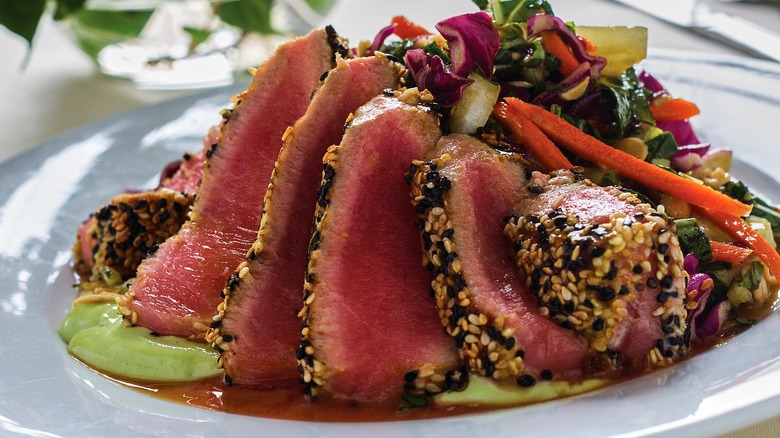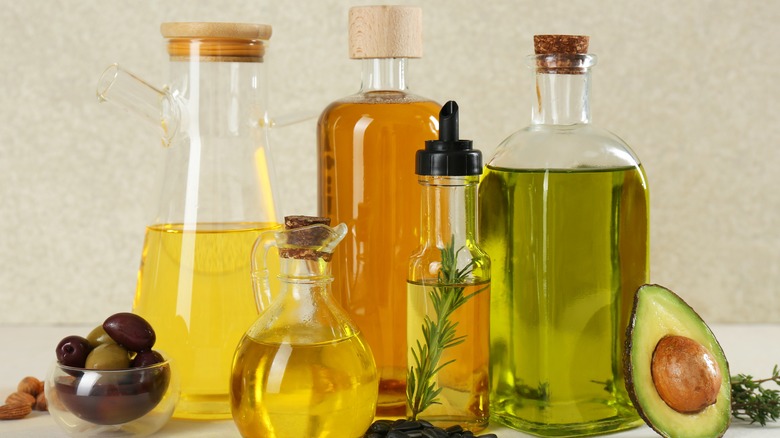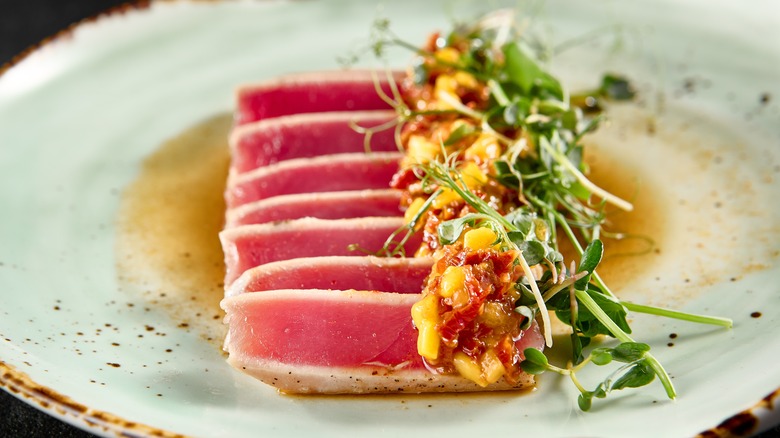Butter Vs Oil: Which Is Better For Searing Tuna Steaks?
Tuna steaks aren't cheap, and if you're cooking your own tuna steak at home, you want to make sure you get it right the first time. Seared tuna is at its best when it's cooked hard on the outside and the inside is still nice and pink. You can boost your flavor experience with a sesame seed mix or furikake on the outside, but one of the biggest factors that might be tripping you up in the kitchen is whether you're searing your tuna steaks in oil or butter.
You very well might be tempted to reach for the butter dish in this scenario. Butter can add a delicious note to so many meals, and if browned properly, it can take on a nuttiness that perfectly complements tuna. Unfortunately, none of those things you love about butter will apply in this case. When the time comes to sear tuna, you're going to want a nice, hot pan with a dollop of oil, like sunflower oil.
While this might be bad news for butter lovers, there's a scientific reason why searing your tuna steaks in oil will give you a better result. If you want that proper sear with pink in the middle, you need a high-quality pan at a high temperature for your tuna steak. We're talking 425-450 degrees Fahrenheit for searing, and at those temperatures, we need to be looking carefully at smoke points.
Why you should sear your tuna steaks in oil
When you're cooking with oil, you want to heat your pan until the oil shimmers. This will create a good sear on the exterior of your food without the oil seeping deeper into it. If you heat the oil even more, though, you'll hit its smoke point. Oil's smoke point, in simple terms, is the point at which it stops shimmering and starts to smoke. Once an oil reaches its smoke point, it starts breaking down, and the resulting chemicals are what gives your food that burnt flavor. This isn't always the end of the world if that flavor is hidden in a larger dish, but when you're cooking a simple, main-event food like a tuna steak, that burnt taste is going to compromise the whole meal.
Butter might taste great on a tuna steak, but when it comes to cooking fat, it has one of the lowest smoke points at just 350 degrees Fahrenheit. If you're searing a tuna steak, you need to use an oil with a smoke point up in that 425- to 450-degrees-Fahrenheit range. That means you also need to avoid oils with low smoke point such as extra virgin olive oil (325-400 degrees Fahrenheit). You're best off going for canola oil (400-475 degrees Fahrenheit), peanut or sunflower oil (both 450 degrees Fahrenheit), or even avocado oil (480-520 degrees Fahrenheit). If you're still feeling lost, here's our guide for when to cook with vegetable versus olive oil.
How to still achieve buttery seared tuna
Butter lovers, fear not — all is not lost. You may not want to sear your tuna in burnt butter, but that doesn't mean you can't put butter and tuna together in the end. The key here is to just not have that butter in the pan with the tuna while it's searing. You can still get all of the flavor in there by just using another pan.
Before you cook your tuna, you can melt some butter (plus garlic and any herbs you might like) in a pan, and then let it sit to infuse while you take care of everything else. You can then pour that butter over your tuna for the last minute that it cooks, or even just after you turn off the pan's heat. Alternatively, you can then serve the butter as a dipping sauce or pour it over the tuna just before serving. This way, you still get that rich, buttery complement to the fish without having to worry about your tuna tasting burnt.


